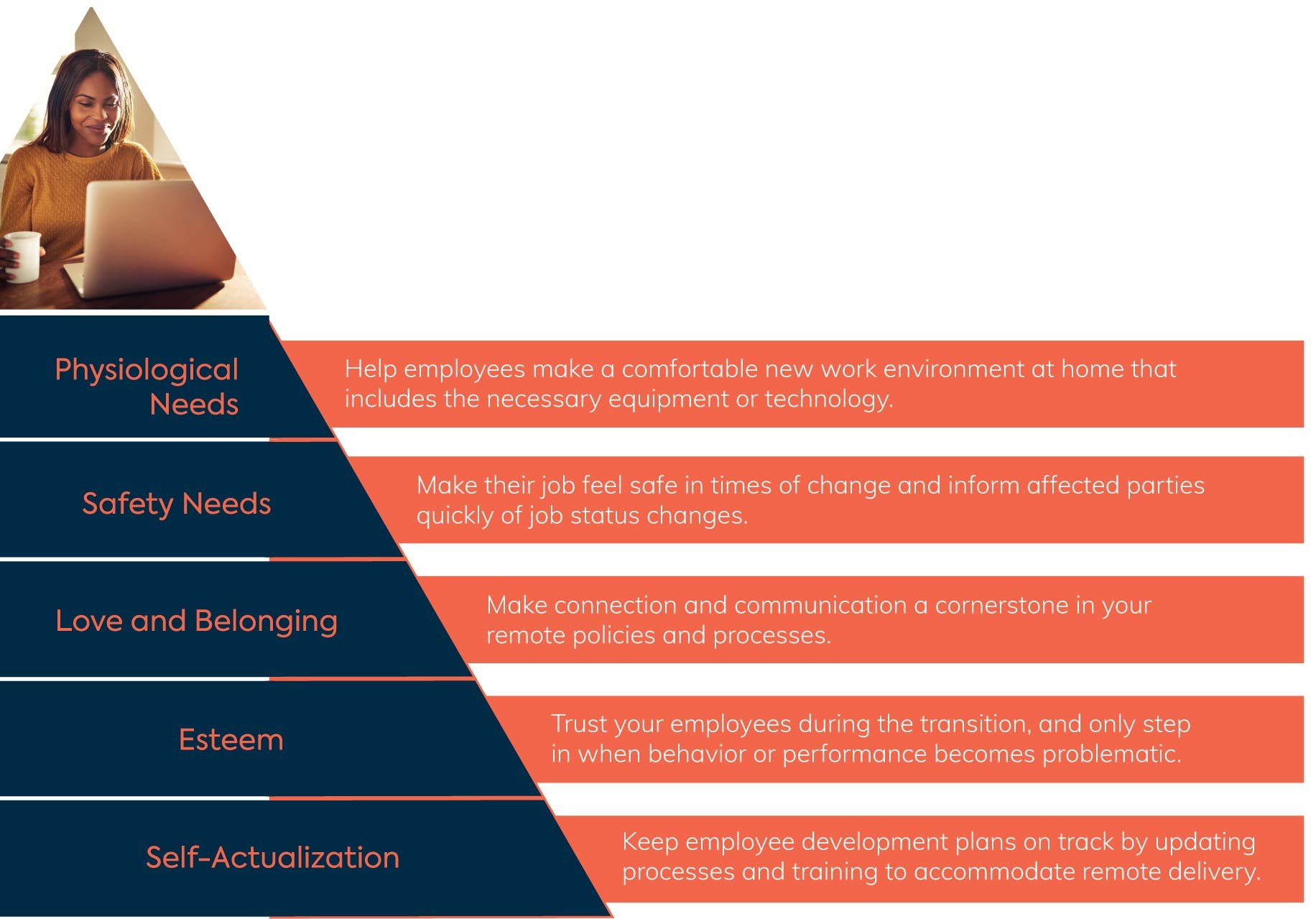KNOWLEDGE CENTER
Transitioning to a Virtual Workplace during COVID-19
The current COVID-19 pandemic is reminding everyone that things can change at any time. When sudden changes arise, organizations quickly learn the weaknesses of their future-proofing strategies and many are forced to create new plans on the fly. To reestablish structure and peace of mind, companies must prepare procedures to usher in a new normal as seamlessly as possible. Moving to a virtual workplace is undoubtedly a significant workflow disruption, but with careful planning, honest evaluation, and appropriate action you can adapt your company’s day-to-day operations to suit a new situation. This guide will help you understand why your business should transition to virtual work, what preparations are needed before the transition, how the transition can be facilitated, and how to guide employees through the change so your business can gracefully continue operating digitally.
The Future of Remote Work Is Coming
When faced with an irrevocable change to the way people do business, do you have telecommuting procedures, technology, and employee expectations in place? Some businesses may view the change to remote work negatively but shifting to a virtual workforce can offer a company many benefits traditional office environments cannot. Remote employees don’t waste time commuting to and from the office, are less distracted by coworkers, and are generally more productive than in-office employees. CoSo Cloud found “of the 39% who work remotely at least a few times per month, 77% report greater productivity while working offsite with 30% accomplishing more in less time and 24% accomplishing more in the same amount of time.”
Using a remote workforce can also save your business money. If your entire staff works virtually, there is no need to rent an office space. Reducing office size or eliminating the physical office can lead to significant savings as Aetna found when they “shed 2.7 million square feet of office space resulting in a cost-saving of $78 million per year.”

Virtual work from home is also shown to make employees happier and healthier. The average commute time for Americans reached an all-time high at just over 27 minutes which has been shown to increase blood pressure and stress levels. Studies have shown that remote workers have lower levels of stress and burnout. No one does their best work while they are stressed or burned out and when an employee isn’t fighting psychological stress, their brain is free to be more creative and flexible. Allowing employees to telecommute also widens your talent pool. Perhaps the perfect employee wants to work for your company but can’t move to be in your physical office. Remote work lets you hire the talent you want without location being a dealbreaker.
Evaluate your Current Offsite Work and Training Capabilities
Before your company can transition to virtual work, you must take stock of your current situation and determine how day to day functions can be completed remotely. There are a few major areas of concern that should be thoughtfully considered before remote work becomes the new normal. Namely essential technology, policies, and processes must be adjusted to suit a virtual workplace without compromising business functionality or performance. Below is an Are We Ready for Virtual Checklist you can reference to determine if your business is ready to go remote.
Technology
- What equipment/technology do employees need to fulfill job requirements?
- Will your employees have secure access to CRM (customer relationship management) and other company programs through a VPN (virtual private network)?
- What communication programs will your company use?
- What organizational method will your company use?
Policies
- What do you expect of your employees in their work-from-home environment?
- Will hours remain fixed or can there be flexibility for full-time or now part-time?
- Will management check in on employees throughout the day to ensure work is being completed?
- Will you allow flexibility for unusual situations? (i.e., childcare, medical issues, store runs)
Process
- Will you hold reoccurring meetings as usual?
- How will you collaborate and discuss issues?
- What other face-to-face encounters need to be adjusted for remote work?
- How will you maintain employee morale?
- Will you incorporate employee wellness into company communications? (Remote employees may need help from their coworkers with childcare and essential supplies)
Fill out this form to have an easy-to-save pdf of Preparing for the New Normal: A Virtual Workplace emailed to you directly:
Transitioning Your Onsite Positions to Virtual Ones
Once you have compiled your checklist, it is time to go about enacting the change to virtual work. Ensure each element of your business’s essential functions is addressed in your transition plan. All the questions in your checklist should have a clear answer before the transition begins so no one is confused before the company goes virtual.
Foundation: The Right Technology
Technology is what allows businesses to work virtually. Without home computers, laptops, and smartphones or Voice Over IP (VOIP) working from home would not be possible. Giving your employees the best tools to do their job from home must be considered a foundational element to success and productivity.
If your employees use technology daily in the office, they will need comparable technology at home to continue fulfilling their duties. Allow employees to take their company-issued computers home so they can continue using the programs and logins they are accustomed to without being forced to download programs on their personal computers. Many Virtual Private Network (VPN) providers offer group licenses for businesses so all your remote workers can keep company data safe while working on home network connections.
Working virtually is not a new concept and thankfully, many programs and apps exist to make remote work easier. Popular communication tools like Slack and Zoom are used in traditional offices, but these programs truly come to the rescue when a company goes virtual. With Slack and Zoom, your company can easily stay in contact, conduct meetings, and collaborate. These programs are intuitive and require little training to use competently, so your employees can adjust quickly. Organizational tools like Trello and Asana can help employees that prefer tangible organizational methods and are struggling with the new digital work style. There are a multitude of apps, websites, and services that aim to help remote employees and companies stay organized digitally. Explore options for company-wide use, but also encourage your employees to stay organized with a method that suits their personal preferences.

Structure: Solid Policies
Rules and expectations that make perfect sense in a communal office might not be feasible or may create unnecessary complications while working remotely. Before you take your business virtual, clearly establish what is expected of each of your employees.
Communication is key. Do not make the mistake of sending your employees home without everyone being on the same page. In uncertain times, your employees will be looking for structure and clarity. Not every question has an easy or instantly available answer but do your absolute best to keep your staff informed as the situation changes.
- If employees are to maintain their standard hours while at home, tell them.
- If your employee’s hours are going to be different, inform them of the change as soon as possible.
- If you will be calling periodically to check-up on your employees, tell them how often to expect calls.
- If there are rule exceptions for unusual or unforeseen situations, clearly explain what events qualify for accommodations.

When creating new policies for remote workers, it is important to remember that each employee has a different work from home setup. One person may live close to a grocery store and will take less time to make a store run than someone else who lives further away. An employee that has kids at home may need different accommodations than an employee that lives alone.
One policy that should not be flexible is security. Before employees work from home, they must understand how to protect company information. If employees want to work outside of their home, they should take protective measures to obscure their screens from curious eyes. Privacy filters are thin sheets of plastic film easily placed in front of laptop and desktop screens so only the person sitting directly in front of the screen can see what is being displayed. Employees that opt to use personal computers instead of work-issued machines should use existing logins for company programs, rather than create new ones, in combination with a VPN and a privacy filter to maximize company security.
Flow: Sustainable Process
Technology and policy will keep your company functioning, but there is one more area that must be addressed before your business goes virtual to keep your employees happy. Moving from a traditional office to virtual work is a stark change for most people and employees may find they miss face-to-face communication more than they anticipated. Designing new processes for offsite work helps ensure communication does not break down and your company culture remains strong.
Recurring meetings barely warrant a second thought in an office, but when an entire company works virtual, meetings become more complicated. Communicate meeting schedules well in advance during virtual work so employees can plan accordingly. Video conferences are generally the preferred substitute for face-to-face meetings but setting up video conferences requires basic technical skills not everyone has. Every employee should receive basic training on whatever conferencing program your business will use so each employee can confidently join meetings from home. Training should be completed before the office closes so meetings are not held hostage or disrupted by technical difficulties.
Once everyone knows how to join virtual meetings, rules for meeting etiquette should be established. Employees should strive for a clean and not distracting background for video meetings. It is very tempting to work in lounge clothes while working remotely, but at least for video meetings, ask that your employees wear normal work attire. Simply putting on work clothes helps employees stay in a work mindset and helps to bring virtual meetings closer to in-person meetings.
Technical and procedural snags are inevitable. While training and etiquette rules can help prevent hiccups, accept that your employees are human and mistakes will happen. During uncertain and unusual times, remember to cut employees some slack as they adjust to their new work life. To improve employee morale, add 5-10 minutes at the end of meetings where employees can ask for or offer help. Maybe someone needs supplies from the store but has no one to watch their kids – a fellow co-worker could offer to pick up the items on their shopping trip and drop the items by. Blocking out a few minutes lets your employees help each other in times of need.

If the majority of your team is new to working virtually, more structured guidance may be needed. Consider a quick course like Josh Bersin’s “The Remote Work Bootcamp” for more in-depth discussion on dealing with virtual work issues.
How to Get Started: Using the Right Resources
Transitioning to virtual work can be awkward, especially for people who are not technically inclined. Outside consultants, experienced virtual workers, or tech-savvy employees can help make the change easier. Tech-savvy employees and experienced virtual workers have the best understanding of your business and can use that knowledge to suggest what options for virtual work would best suit the business. . Outside consultants can help with transition strategy, setting up eLearning courses or Virtual Instructor-Led learning, suggesting programs to make the transition easier, and offering their professional advice.

Telltale Signs Telecommuting Isn’t Working and Possible Solutions
Working remotely can be successful, but not every employee rises to the challenge. Without sitting in an office surrounded by coworkers hard at work, the pressure to stay on task can wane. There can be far more distractions in a home than there are in an office for some employees. If an employee is missing deadlines, late for meetings, or their work quality has dipped, they could be struggling with telecommuting. As soon as these warning signs become noticeable, have an honest conversation with the employee and ask about their difficulties. Just because an employee’s performance is sliding, that doesn’t mean they are doing it on purpose. Did they miss the meeting because their kid was sick or were they truly slacking off? If an employee admits they are easily distracted, suggest organizational or productivity apps. An employee responsible for childcare may need flexible hours to accommodate their family needs. Not every employee may be honest but try your best to understand why they are struggling and offer solutions for their unique problems.
Once you have exhausted possible solutions and done your best to help your employee succeed while working remotely, the responsibility falls on them. Not everyone is wired for offsite work, but after collaborating for answers, it’s the employee’s job to incorporate them and keep their work at the expected quality.
Feed Your Employees’ Maslow’s Hierarchy of Needs
At the end of the day, we are all wired with the same fundamental human needs. Maslow famously created his hierarchy of needs and as your business moves to virtual work, it is important to ensure your employee’s needs are being met. Happy employees work better, so keeping your team’s needs met helps your business, especially during uncertain times.

Moving an entire company to remote work is difficult and presents many challenges, but with proper planning, the transition can be successful with minimal disruptions. Work with your team to develop the best strategies for creating a new sense of normal so everyone can get back to work in their new environments.
List of Resources
Patrick Lencioni offers great resources to help teams function more effectively, in particular a webinar series on coping in times of crisis with wonderful insights on serving your clients:
https://www.tablegroup.com/capa/
Becoming Your Best presents a podcast on The Principles of Successful Leaders – How to Survive and Thrive During Hard Times. There are many others on their site that are great.
Here is information about Appian’s free COVID-19 Response Management Application. The webinar and app are great.
https://www.appian.com/covid19-response-management/
This discusses market transformation during COVID-19:
https://www.mattranen.com/blog/2020/4/7/transform-now-while-market-confusion-gives-you-air-cover
These are free Remote Working Reports to Help Individuals & Businesses from Bestwork Data:
https://corp.bestworkdata.com/
This article is about the difference between emergency remote teaching and online learning from EducauseReview:
Focusmate helps bring accountability to remote work by providing a platform for virtual coworkers to meet and get things done: https://www.focusmate.com/
The Josh Bersin Academy offers training called The Remote Work Bootcamp available their subscribers.
https://bersinacademy.com/the-remote-work-bootcamp
Steve Shallenberger explores The Art of Pure Listening in his podcast on becoming your best self.
https://www.becomingyourbest.com/episode-223-the-art-of-pure-listening/
eLearning Industry discusses What The COVID-19 Pandemic Means For Workplace Training in this article.
https://elearningindustry.com/what-covid-19-pandemic-mean-workplace-training
Fill out this form to have an easy-to-save pdf of Preparing for the New Normal: A Virtual Workplace emailed to you directly:


